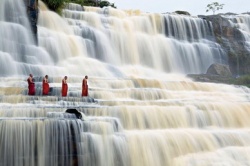Buddhist Approach to Overcome Environmental Crisis by Dr. Bikiran Prasad Barua
Introduction
The environmental crisis is a global truth .By environment we understand Physical and biological surroundings of an organism. The environment covers non-living ( a-biotic) and also living ( biotic) organisms such as plants , microorganisms and animals’. The nature, environment, ecology, ecosystems are all related to each other . These subjects are of great concern of study today by the people in this planet earth. The great Scientist Albert Einstein while defining environment has told that “Everything that isn’t me is environment”. In a greater sense it may be stated that you are the part of my environment and I am the part of your environment. Again many researchers have defined environment as “the sum total of the conditions that affect the development and life of organisms”. According to the scientists the environment is the suitable coordination of five important elements such as soil, water, air ,plants and living beings.
Minute but complex equilibrium has been created in the environment of this planet earth through millions of years of the order of gradual manifestation. At present the equilibrium of this environment is in fatal disruption. By this, environment has been polluted and it is still an ongoing process. The reactions of environmental pollution on the planets and living beings are a far-reaching affect, in some cases at the present it has become very serious.
World Views on Environmental issues
The World Commission on Environment and Development (1988) in its ‘Our Common Future’ report book has marked two things for environmental non-equilibrium or pollution- one is poverty and the other is economic growth. In that book in page 28 it has been mentioned while describing Symptoms and Causes that “Environmental stress has often been seen as the result of growing demand on scarce resources and the pollution generated by the rising living standards of the relatively affluent. But poverty itself pollutes the environment , creating environmental stress in a different way. .Those who are poor and hungry will often destroy their immediate environment in order to survive. They will cut down forests , their livestock will overgraze grasslands, they will overuse marginal land and in growing numbers they will crowd into congested cities. The cumulative effect of these changes is so far-reaching as to make poverty itself a major global scourge.
On the other hand , where economic growth has led to improvements in living standards , it has sometimes been achieved in ways that are globally damaging in longer term. Much of the improvement in the past has been based on the use of increasing amounts of new materials, energy, chemicals, and synthetics and on the creation of pollution that is not adequately accounted for in figuring the costs of production processes. These trends had unforeseen effects on the environment. Thus today’s environmental challenges arises both from the lack of development and from the unintended consequences of some forms of economic growth..
Thus it seen from the report from the commission formed by the United Nations . that the causes of environmental pollution are :poverty, and excessive use of natural resources for the standard livelihood of the people of the developed countries. Many people mention about three ‘P’s for such global calamity. These are : Pollution, Population and Poverty.
The World Commission on Environment and Development in its report (page 95) on Population told that “ In 1985 , some 85 million people were added to a world population of 4-8 billion. Each year the number of human beings increases, but the amount of natural resources with which to sustain this population, to improve the quality of human lives, and to eliminate mass poverty remains finite. On the other hand expanding knowledge increases the productivity of resources.
Present rate of population growth cannot continue …An additional person in an industrial country consumes far more , and places far greater pressure on natural resources than an additional person in the Third World. Consumption patterns and preferences are as important as number of consumers in the conservation of resources.”
The World Commission on Environment and Development in its report ( page 27) commented on “Threatened Future” that “ The earth is one but the world is not. We all depend on one biosphere to sustain our lives. Yet each community , each country, strives for survival and prosperity with little regards for its impact on others. Some consume the earth’s resources at a rate that would leave little for future generations. Others, many more in number, consume far too little and live with the prospect of hunger , squalor, disease and early death. Yet progress has been made…..”
The Commission again in its report in a an Overview “ From one Earth to one world” mentioned that “ In the middle of the 20th century we saw our planet from space for the first time. Historians may eventually find that the vision had a greater impact on thought than did the Copernican revolution of the 16th century which upset the human self- image by revealing that the Earth is not the centre of the Universe. From space, we saw a small and fragile ball dominated not by human activity and edifice but by a pattern of clouds , oceans, greenery and soils.. Humanity’s inability to fit its things into that patterns is changing planetary systems fundamentally. Many such changes are accompanied by life-threatening hazards . This new reality, from which there is no escape, must be recognized and managed.”
Types of environment
Generally environment is divided into two parts. One is physical environment which consists of soil, water, air, light, heat and organic and inorganic salt mixed with soil and water. The other is organic environment which comprises of plants and living beings. Because of total activities of humans both physical and organic environments are polluted But it may be mentioned that all the elements of the environment are related to each other . If any one of them is affected , there will be influence on others also. In this age of developed science and technology as mechanization has increased , in the same way the complexity of life has also increased. But primary destruction has started centering the environment. Though the word the “Environmental Pollution” is a matter of discussion throughout the earth, in fact, this has started from long time ago. But man has become careful or conscious only a few years ago. Now–a-days it is regarded as environmental crisis.
Global Overview of Environment in terms of energy
If any body wants to discuss on the problem of environment , one must have some idea about the global overview of environment. Basically environmental pollution means air pollution, sound pollution, water pollution, soil pollution. As I am a Physicist , I think it is wise to look into this pollution or problems in terms of energy.
In fact, calamity in environment is due to the cause of difference in the use of energy. It is told that the poor are using woods as fuel energy for their survival. By this there occurs deforestation.. Sufficient plants have been wanting to absorb carbon dioxide created from different sources. Rate of deforestation is much more faster that the creation of forest zone. On the other hand in the developed countries the use of per capita energy is much more higher than the third world. If we want to bring the use of energy equivalent to the developed country , five times energy is to be increased in the third world. But still it will not be sustainable. It may be suggested that means to revival of renewable energy will bring not only for the third world but also for the developed world it may be an idealistic situation for the energy. Of course. there are many sources of energy such as natural gas, oil, coal, rotten plants in water logging ponds, nuclear energy, wood, trees, cow dung, falling water, source of land-heat, and solar energy, ebb and flow tide, and muscular energy of men and animals etc.
Role of Carbon dioxide in the environmental pollution
Since the inception of the earth carbon-dioxide has played an important role as an element to control the temperature of the earth and its atmosphere. In absence of carbon-dioxide and water vapor the average surface temperature of the earth would be -19 degree centigrade. Since these are present the average surface temperature of the earth is now +15 degree centigrade. It means if the temperature of the earth’s surface would be -19 degree centigrade the earth would be frozen one. But in everyday smoke emission from fossil fuel, oven of kitchen, chimney of industries, automobiles, smoke from air planes , smoke from generators used in motors and industries, coal smoke, ash smoke from brick fields, breathings of human beings, smoke from cigarettes and many other elements are being added to the existing components of the earth’s atmosphere.. Amongst these, emission of carbon dioxide gas is 27 decimal times greater than before the industrial revolution and at present it is increasing at the rate of 0.5 decimal (WCED report). In one estimate it is seen that the amount of carbon dioxide which was existing in the year 1980 will be doubled at the middle of the 21st century. Besides these, toxic gases like methane, nitrous oxide, ozone, chlorofloro carbon (CFC), carbon monoxide (CO), sulphur dioxide, hydrogen sulphide, nitrogen dioxide are being added to the atmosphere. These toxic gases are polluting the whole environment. Trees , rivers-canals-marshy land-sea water absorb much of the accumulated carbon dioxide in the air. But the rate in which the forest properties are being destroyed , new forests are not being developed at the same rate to absorb carbon dioxide from air. As a result carbon dioxide in air has created a warm atmospheric surface by absorbing sun rays from the sun and also by absorbing reflected heat from the earth’s surface.. By this, regularly, the temperature of the atmosphere will be increasing which is supposed to be known as global warming. I think a little bit more information should be given about carbon dioxide. The World Commission on Environment and Development in its report in the year 1988 ( page 56) has mentioned that “ The total atmospheric reservoir of carbon dioxide is equivalent to 743 Gtc ( Gtc=gigatonnes of carbon. Gt= 1 billion tones ) which is much smaller than 1760 Gtc for the terrestrial biosphere, of which about 560 Gtc is stored in trees and plants and in tiny compared with 39000 Gtc in the oceans.. The atmospheric concentration is therefore susceptible to rather small changes in the fluxes between these reservoirs.. The current rate of emission of carbon dioxide from the burning of fossil fuels is 5.4 Gtc/year , while the net emission due to deforestation and changes in land use are estimated at 1.6 Gtc/year.”
Environmental pollution brings climate changes causing global temperature change
As we mentioned earlier humans are responsible for such kind of environmental pollution. The changes in the chemical composition of the global atmosphere bring lot of havoc in this planet earth.. Green house gases ( carbon dioxide and methane gases) are heating up the planetary: atmosphere rather global warming brings unexpected changes in the climate . As a result it is observed that precipitation, cloudiness, soil moisture, melting glaciers, snow cover, rising sea levels, expanding deserts, shrinking forests, disappearing plants and animals, droughts, drinking water shortages, storms, cyclones, tidal bores, calamities, tsunamis, tornado, hurricanes, floods, disaster, falling water tables ,destruction of eco systems, ecological damage, increasing ocean acidification, acid rains, depletion of ozone layer, expansion of ozone hole, fires, landslides, mudflows are the effects of climate change rather increase in average global temperatures. .Human beings are thus facing threats of extinction from these above types natural disasters. These effects have become so dangerous to the human beings that they have been bound to take necessary steps how to preserve environment from degradation or pollution..
Alarming Global warming
Very recently I have translated a lecture of Most Venerable Grand Master HsingYun into Bengali. Most Venerable Master Hsing Yun is the Founder of Buddha’s Light International Association ( BLIA) whose headquarters is situated in Los Angeles, USA. During the BLIA General Conference held in Fo Guang Shan in 2010 in Kaohsiung , Taiwan Venerable Master delivered a keynote speech on “Environmental and Spiritual Preservation”. This was an extraordinary exemplary thoughtful lecture which needs to be understood in this modern world. From his Lecture I am quoting a few lines what will happen if the temperature of earth’s surface or global warming rises by six degrees Celsius:
“ Up till now , the focus that every nation is paying close attention to is still on the fight against global warming. Now-a-days many western scientists have continuously worried humanity with statistics on the seriousness of global warming. If people do not pay attention to environmental preservation , and do not control the emission of carbon dioxide, then by the end of this century, the earth’s temperature will rise from 1.4 degrees to 6.4 degrees. When the time comes , it will cause destructive changes to humanity’s future.
How do you let all the people understand global warming ? Including the natural calamities that the increase of one degree Celsius will bring to humanity ? National Geographic broadcasted a special documentary called “Six Degrees Could Change the World”.
The documentary explains that when the entire earth’s temperature increases by one degree , Western Unites States would face severe droughts where most of it will turn into deserts.
When the earth’s temperature increases by two degrees , Greenland’s glaciers will melt first . When the time comes, the sea level will rise up to seven meters. Some coastal cities including New York, London, Manhattan, Shanghai or Taipei, will be entirely flooded.
When the earth’s temperature increases by three degrees, after passing the critical point , humanity will have no power to control global warming. When that time comes, the summer heat wave in Paris will become a regular phenomenon. There will be no ice in the North Pole during summer. The Amazon Rainforest will gradually wither , and the drought may even cause rainforest fire.
When the earth’s atmosphere increases by four degrees, Bangladesh, Egypt and Venice would be flooded by ocean. The world’s largest rivers may dry up , jeopardizing the existence of millions to billions of people.
When the earth’s temperature increases by five degrees, the North and South Temperature Zones will be unsuitable for living. Water sources in Los Angeles, Mumbai and Cairo will dry up. When that time comes, the number of climate refugees around the world cannot be estimated.
When the earth’s temperature increases by six degrees , many of the major cities will be lost to the rising seas. When that time comes, natural disasters will become a norm. When that day arrives, it is the so-called “ end of the world”. Humanity will probably follow the extinction of the dinosaur kingdom. From then on, human civilization will no longer exist..”
Hurricanes hit different countries
Within last few years hurricanes in different names hit different coastal cities and caused severe damage to not only humans but also to the nature . Very recently various types of hurricanes caused a severe damage in New York and other cities of USA and also other cities of the earth.. This is due to global warming or rather temperature increase of earth’s surface and also sea water temperature increase. There is a proverb, “ Save the nature, nature will save you.”. We are not making any justice to nature as it expects. On the other hand , we are doing injustice to the nature to satisfy our ego, greed, selfishness etc. Merciless exploitation of natural resources are the root causes of such a crisis.
Minimization of Environmental pollution or degradation
The temperature of the earth or global warming has reached in such a state that it cannot be reduced to an early state when the degree of pollution was not so severe. As now –a-days even in developing countries industries are being developed and the human beings are utilizing the earth’s resources without any limitation there is no possibility to return back to early state.. What humans can do is that if the people can be awakened the pollution may be minimized through their actions in day to day life. There exist many environmental concerned world and local organization which are actively engaged or devoted to promoting the environmental degradation further and trying to maintain the ecological systems of nature. There was a protocol signed in Montreal in the year 1978 amongst the concerned nations that CFC emissions will have to be reduced to 50% by 1998. In Helsinki conference in 1989, 86 countries signed a protocol to remove all the usable destructive chemical elements which will affect the ozone layer. But the ozone whole which has been detected in the ozone layer cannot be returned to original condition. Now the question is whether the present position of environment can be maintained in the days to come? This answer depends on the role of people dealing with such environment to be more polluted or to keep in this state..
Buddha’s teachings regarding environment
If we go through The Buddha’s life we can clearly understand how much The Buddha loved the nature. First of all The Buddha was born in Lumbini Yard in Nepal. His birth was not at Royal Palace but it was a place which was full of natural beauty in a free and clean atmosphere . So one can imagine how long this place was chosen . He was born as Siddhartha to be the future Buddha . The very birth of the Buddha in Lumbini forest indicates that Buddhism emphasized on nature and its protection. He was going to be The Buddha after four innumerable cycles of births and rebirths, after 550 times births as Bodhisatta and as a birth place Lumbini was chosen.
Before attaining Buddhahood, in a ploughing festival in a village accompanied by his father Suddodana Prince Siddhartha sat under a Jambu tree and got absorbed in a trance and meditated .Before attaining Buddha hood Goutama took milk-rice from Sujata under a banyan tree . That provided many birds’ habitants, insects thus mentioninf about ecological balance.
Secondly Siddhartha Gautama started his deep meditation practice in deep forests , hills of nature and ultimately became the Enlightened One in Uruvilla Forest ( at present Bodhgaya). One can clearly realize the natural beauty of Uruvilla forest was the suitable place to be The Buddha- the supreme being of the world. It was a place of tranquility, peaceful, natural , and full of fresh air which has helped to keep his body fit even without any food for long 49 days. In the fifth week The Buddha sat for seven daya under Ajapala Nyagrodha tree 9 generally known as goat Herd’s Banyan tree); in the sixth week The Buddha sat under the Muchalinda tree for seven days; in the seventh week the Buddha passed seven days under Rajayatana tree. Late Dr. Asha Das. A renowned Buddhalogist of India said that all these trees are associated with Buddha which dominated very turn in his life.
The Buddha preached his first sermon Dhammacakkapabattansutta to his earlier colleagues ( later on pancha baggiya disciples) in the Deer Park (Migadava) at Isipatana, a woodland. While approaching towards Kushinara the Buddha stopped under the Mango Grove of Cunda. The Buddha passed away at Sala forest of Malla at Kushinara.
Even the Physician Jibaka of The Buddha was an expert in collecting medicinal plants from the nature for Buddha’s treatment.. So one can imagine how much importance is given in Buddhism to save the nature. In Theravada system monks are not allowed to cut the trees and plants The Buddha introduced retreats for the monks during the rainy season. The monks would not beg for alms because while walking their steps may kill the insects and the young sprouts on the ground. The Buddha showed an extraordinary zeal in spending time amidst natural surroundings which are seen throughout eighty years of his life and also in Jataka stories ( stories o past lives.)
It is emphatically observed that echo-friendly and environment loving are related to the great compassionate thinking of the Buddha. From his teaching we can clearly understand thet reverential perception of humanity towards trees and plants can save the global crisis of environmental degradation.
The Buddha’s precepts
The Buddha introduced precepts for human beings to lead a good, pure and descent life. In the five precepts the first one is to abstain from killing. living beings.. The killing may be direct one or may be indirect. In highly industrialized countries where there are lot air planes, use of refrigeration etc producing CFC and other toxic gases while polluting the earth’s atmosphere are killing many species of the world indirectly. The disappearance of thousands of species are causing ecological imbalance. In the name of festival there are lot of religions in the world .which kill billions of animals for eating . But history says that the great Emperor Asoka established hospitals for animals , built forests by planting trees for providing shelter to the animals. Precept of killing is key to environmental preservation or to protect environmental pollution. As there is a great hole in the ozone layer discovered by the British scientists, ultra violet rays are coming from the sun to the earth’s surface and these fatal rays are causing detrimental effects on humans and living beings including cancer, skin diseases et. Many living beings are dying out of these rays. So if we think how this has been created in the ozone layer. It is the toxic gas creating hole in the ozone layer. From where this toxic gases are coming ? From industries. .So in turn science and advanced technology are indirectly responsible for killing living beings through various types of acute diseases.. The teachings of The Buddha are concerned with the protection of wildlife and environment.
Why the environment has become so much polluted ?
According to Buddhism, the environment has become so much polluted because of excessive delusion , greed and hatred of humans.. During the second world war atomic bombs were dropped in Hiroshima and Nagasaki. Killing thousands and thousands of people this bombing destroyed the whole environment not only of Japan but also of the whole world. When these bombs were tested in Mexican deserts the atmosphere experienced pollution of nuclear hazards as at that time of bombing the whole of Japan and neighboring countries experienced about the dangerous effects of nuclear hazards causing unimaginable sufferings to the human and all living beings. Very recently nuclear power plant disaster . has caused severe effects in environment . Ultimately in some ways or other this will affect on the species of the world and ecological balance will be lost.
Environment crisis is man made crisis. So man’s mind must be free from pollution .As a result the earth has become sick. If a person is sick he is to be given proper treatment to be free from his sickness. As such environment and ecology are to be given proper treatment to be free from pollution. What are those treatment ? The very first treatment is make men free from mind pollution.. According to Buddhism because of ignorance everything arises out of ignorance or delusion or moha. If anybody is to be freed from ignorance he must have spiritual development through meditation.
Conclusion
The Buddha’s teachings stress on respect for other’s life ( abstinence from killing living beings); respect for other’s properties ( abstinence from stealing), respect for women ( abstinence from sexual misconduct), respect for truthful words ( abstinence from telling a lie),; respect for one’s own body ( abstinence from taking alcohols); universal loving kindness, great compassion, altruistic joy, equanimity; right livelihood ( not to be involved in business on living beings, business on flesh or meat; business on arms; business intoxicants; business on poisonous materials); meditation; love for the humanity; wisdom, love for the earth and nature; to know oneself ( having insight knowledge); to make oneself free from delusion or ignorance, greed and hatred through acquiring wisdom; charity and loving kindness respectively etc.
As I told earlier it is not possible to return back to environment of earlier days. But by the practice of The Buddha’s teachings we can minimize or overcome the environmental pollution if there is a sense of awakening amongst those countries which are producing maximum toxic gases in the world and keeping remarkable contributions in polluting the environment thus the environmental crisis.
In Karanaiya Metta Sutta The Buddha said that “ As a mother loves his son and protects her at the risk of her life, such kind of unbounded love and compassion are to be extended for all beings ( sentient and non-sentient beings)”. In the same Sutta in another verse The Buddha said that “ Whether seen or unseen, who lives near and far away; born or to be born, let all beings be happy”. What a wonderful verse.. No other great man could tell let all beings be happy.
To make all livings happy The Buddha emphasized on the Kerma of oneself. As you sow so you reap. If you destroy the nature, nature will destroy you . There is no exception.
It may be mentioned here that every year UNDV (United Nations Day of Vesak) is observed in Thailand except in 2008 when UNDV was observed in Vietnam. I had the privilege to participate in UNDV celebration and also in the International Buddhist Conference. In connection with the conference there were always topics related to environment, ecology. There are lot of valuable articles on this environmental crisis. We the Buddhists must think that environment is global phenomenon. There are lot of suggestions how to preserve the environment and make the humans free from environmental crisis. In that sense our view should be: “We must think globally but act locally”.
My recommendations on this subject of crisis will be:
1. Based on The Buddha’s teachings for nature all the Buddhist organizations of the world should sit together and specifically discuss on this issue how we can help the world community to get rid of crisis.
2.As Buddha’s teachings tell us that everything is interconnected and interrelated through the concept of dependent origination, the theory must reach the scientists and technologists of the developed country so that there brings no harm for their actions to the living beings of the world specially to the existing environment..
=
Source
=
- Environmental and Spiritual Preservation , a Lecture by Most Venereable Grand Master Hsing Yun, BLIA General Conference October 2-7, 2010, Fo Guang Shan, Taiwan.
- Sandhan, a Quarterly Science Journal published by Chittagong Science Council .’April-June 2007, Article on environment by the writer.
- Buddhist Approach to Environmental Crisis, UNDV Conference Volume , 4-6 May 2552/2009, Thailand.
- Global Recovery: The Bufddhist Perspective, UNDV Conference Volume, 23-25 May 2553/2010, Thailand.
- Buddhist Virtues in Socio-Economic Development, ICDV Conference Volume,.12-14 May 2554/2011, Thailand.
Source
Author: Dr. Bikiran Prasad Barua
buddhismandaustralia.com







